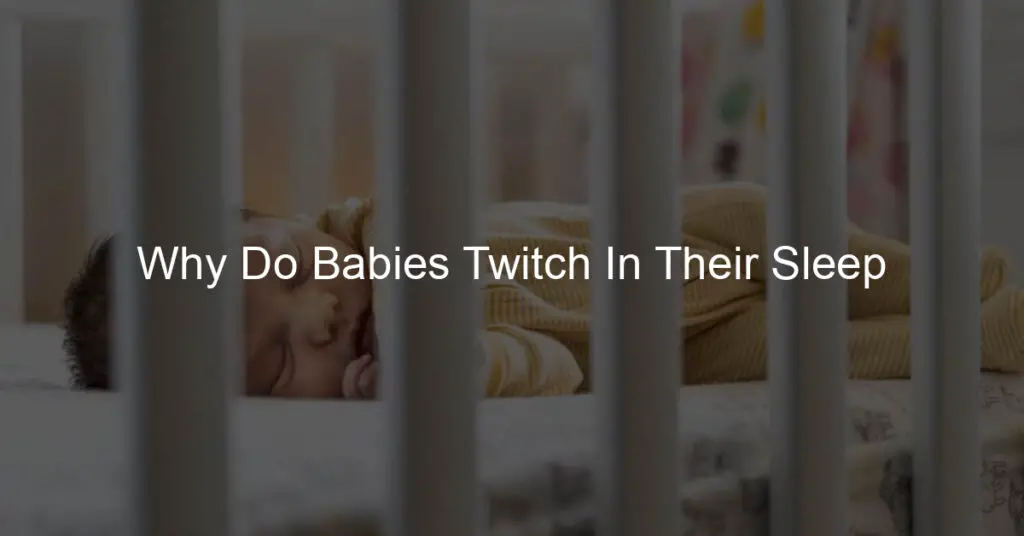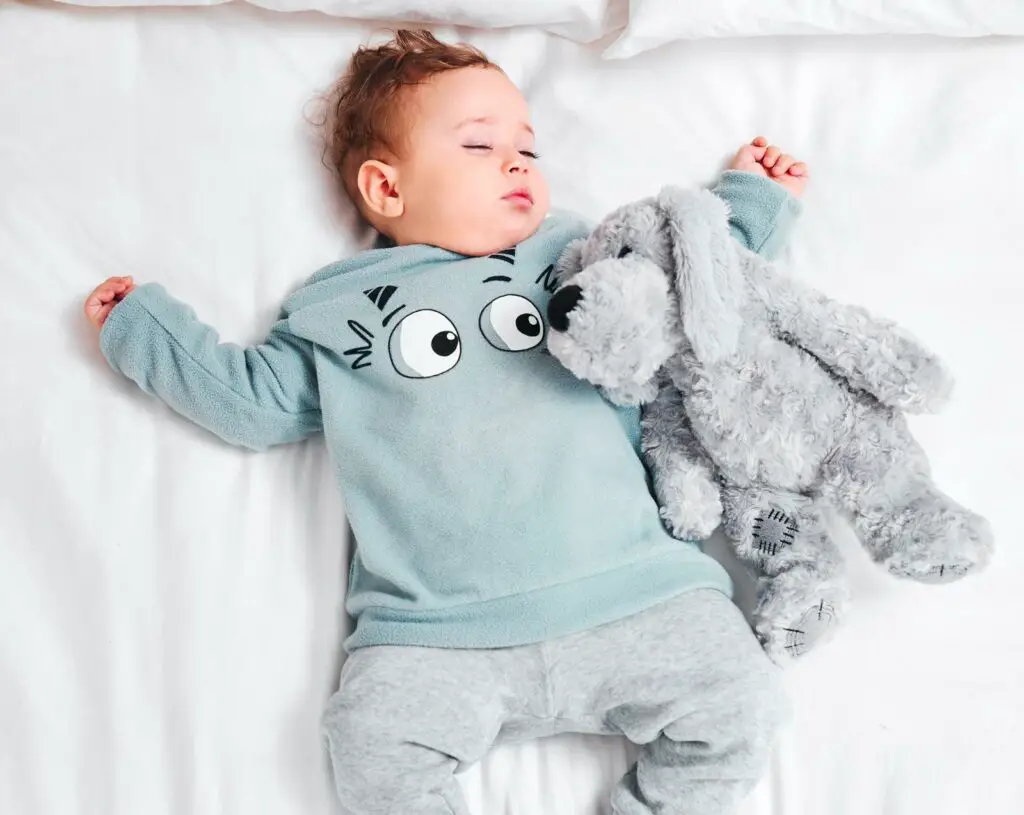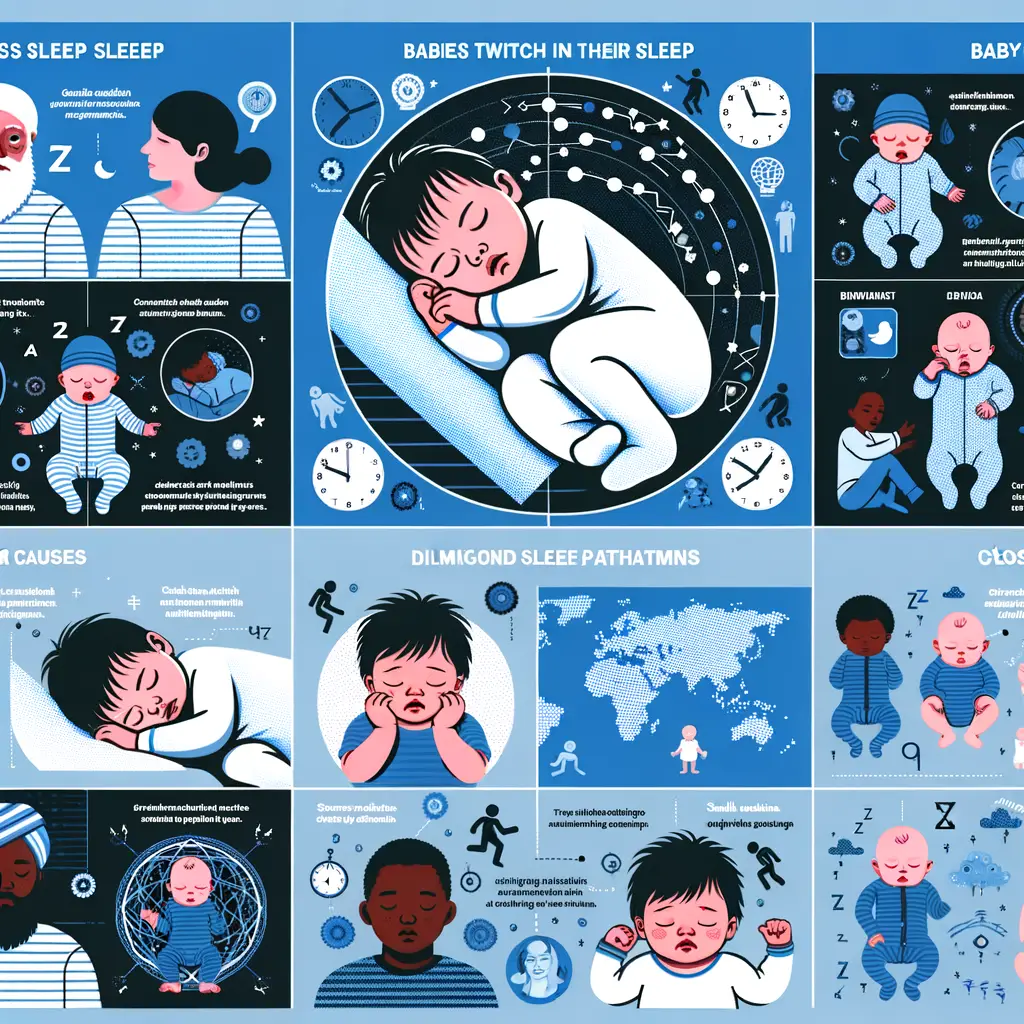Introduction: Decoding Baby Sleep
Every parent knows that understanding a baby’s sleep pattern can be a daunting task. Babies have their unique sleep habits, and these can often seem mysterious and confusing. This blog post aims to shed some light on the subject, helping you understand your baby’s sleep patterns and the mystery of their night-time twitches.
Understanding baby sleep patterns
Just like adults, babies have sleep cycles. However, these cycles are much shorter and can vary greatly. A newborn baby, for instance, spends about 50% of their sleep in the rapid eye movement (REM) stage, which is associated with dreaming. This is significantly more than the 20-25% that adults spend in REM sleep. As babies grow, their sleep patterns begin to resemble those of adults more closely. By the age of six months, a baby’s sleep pattern is quite similar to that of an adult.
Understanding your baby’s sleep patterns can help you anticipate their needs and create a sleep schedule that works for both of you. It’s important to remember, though, that every baby is unique and what works for one might not work for another. Here is a link to a Wikipedia article that provides more detailed information on baby sleep patterns.
The mystery of night-time twitches
Have you ever noticed your baby twitching in their sleep? This is a common occurrence and is usually nothing to worry about. These twitches are part of your baby’s normal development and are a way for their brain to map their body and test out their reflexes. They’re most common during REM sleep, which, as we’ve mentioned, babies spend a lot of time in.
While these twitches can sometimes look alarming, they’re usually completely normal. However, if your baby’s twitches are frequent or they’re accompanied by other unusual symptoms, it’s always a good idea to consult with a healthcare professional. You can read more about night-time twitches in babies here.
Understanding Baby Twitches: An Overview
When your baby sleeps, you may notice a variety of movements. These can range from small twitches to larger jolts. Understanding these movements can help you ensure your baby is sleeping well and developing normally. In this section, we will explore what baby sleep movements are and how to differentiate between normal and abnormal twitching.
Defining Baby Sleep Movements
Baby sleep movements are the physical actions your baby makes while they are sleeping. These can include everything from small twitches of the fingers and toes to larger movements like rolling over. These movements are a normal part of your baby’s development and are often a sign that their nervous system is maturing. According to Wikipedia, these movements can be more pronounced during the rapid eye movement (REM) stage of sleep, when your baby is most likely to dream.
Normal vs. Abnormal Twitching in Baby’s Sleep
While most baby sleep movements are normal, some may be a sign of a medical issue. Normal baby twitches are usually small, quick, and occur sporadically. They can happen at any time but are most common during REM sleep. These twitches are often a sign that your baby’s nervous system is developing and maturing.
On the other hand, abnormal twitching can be a cause for concern. If your baby’s twitches are frequent, rhythmic, or accompanied by other symptoms like fussiness, it might be a good idea to consult a pediatrician. These could be signs of a neurological disorder or a sleep disorder. However, it’s important to remember that every baby is different, and what’s normal for one baby might not be for another.
In conclusion, understanding your baby’s sleep movements can help you ensure they are developing normally. If you notice any unusual twitching, don’t hesitate to consult with a healthcare professional.
Reasons for Baby Twitching in Sleep
One of the most common phenomena observed in infants is twitching during sleep. While it might seem concerning to new parents, it is generally a natural process linked to the baby’s development. Let’s delve into the reasons behind this behavior.
Infant Sleep Twitching: A Natural Process
Infant sleep twitching is a normal part of a baby’s growth and development. It plays a crucial role in the development of the baby’s brain and refining their motor skills. Here’s how:
Role of twitching in baby’s brain development: When a baby twitches during sleep, it is a sign that their brain is working on new motor skills. This twitching is a form of communication between the brain and the muscles. It helps the brain map the body and understand which muscles to activate for different movements. This process is essential for the baby’s brain development and learning how to control their body. Learn more about motor skills on Wikipedia.
How twitching helps in refining motor skills: The twitching movements help the baby’s brain to understand and refine the motor skills. Each twitch sends a signal to the brain about a specific muscle movement. As the baby grows, these twitches become more coordinated and controlled, leading to refined motor skills. This is why you might notice your baby’s twitching movements become more refined over time.
In conclusion, infant sleep twitching is a natural and essential part of a baby’s development. It is a sign that your baby’s brain is actively working on new motor skills. So, the next time you see your baby twitching in their sleep, remember that it’s just their brain at work!
Newborn Twitching While Sleeping: Common Causes
As parents, it’s natural to worry when we see our newborns twitching in their sleep. But rest assured, this is usually a normal part of their development. Let’s explore some of the most common causes of newborn twitching during sleep.
REM Sleep
During the Rapid Eye Movement (REM) stage of sleep, your baby’s brain is highly active. This activity can often result in twitching. It’s a natural part of the sleep cycle and helps in the development of their motor skills. More about REM sleep on Wikipedia.
Startle Reflex
Also known as the Moro reflex, this is a response to a sudden loss of support, feeling like they’re falling. It’s a normal reflex for an infant and can cause twitching during sleep. This reflex gradually disappears by the time they are 3 to 6 months old. Learn more about the Startle Reflex on Wikipedia.
Neonatal seizures
While less common, neonatal seizures can cause twitching in newborns. These seizures are usually a sign of a serious health condition and require immediate medical attention. If your baby’s twitching is accompanied by other unusual symptoms, it’s best to consult a doctor. Read about Neonatal seizures on Wikipedia.
Remember, while twitching is usually a normal part of a baby’s development, it’s always best to consult with a healthcare professional if you have any concerns about your baby’s health.
Decoding Baby Sleep Behavior: Twitching vs Spasms
As parents, we often find ourselves observing our baby’s sleep patterns and behaviors. One common occurrence that may catch our attention is the twitching movements they make during sleep. It’s important to understand the difference between normal baby sleep twitches and spasms that may require medical attention.
Understanding Baby Twitches
When your baby is asleep, you may notice small, rapid movements. These are known as twitches and are a normal part of your baby’s development. Let’s delve into understanding these twitches better.
Identifying normal baby sleep twitches
Normal baby sleep twitches can be seen as quick, jerky movements of the baby’s arms, legs, or face. They usually occur during the baby’s REM (Rapid Eye Movement) sleep phase. These twitches are a part of the baby’s motor development and are completely normal.
When to be concerned about twitching in baby’s sleep
While twitching is usually normal, there are instances when it could be a cause for concern. If the twitching is accompanied by other symptoms like difficulty breathing, blue lips, or if the twitching continues even when the baby is awake, it’s time to consult a doctor. It’s always better to be safe and get any concerns checked out.
Understanding your baby’s sleep behavior can help you ensure they are growing and developing healthily. Always remember, when in doubt, don’t hesitate to seek professional medical advice.
Infant Sleep Spasms: What You Need to Know
As a parent, it’s natural to worry about every little thing your baby does, including their sleep behavior. One such behavior that might cause concern is infant sleep spasms. Let’s delve into what these are, their causes, and when to seek medical attention.
Defining Infant Sleep Spasms
Infant sleep spasms, also known as infantile spasms, are a type of seizure disorder that occurs in babies. These spasms are characterized by a sudden, brief stiffening of the muscles. Your baby might bend forward or arch their back while their arms and legs stiffen. These spasms usually occur when the baby is waking up or going to sleep.
Causes of Sleep Spasms in Babies
There are several potential causes of sleep spasms in babies. Some of these include brain malformations, genetic disorders, and metabolic diseases. However, in many cases, the exact cause remains unknown. It’s important to remember that these spasms are not caused by anything the parents did or didn’t do.
When to Seek Medical Attention
If you notice your baby having frequent spasms, especially upon waking or falling asleep, it’s crucial to seek medical attention immediately. Early diagnosis and treatment can help manage the condition and prevent potential developmental delays. Remember, it’s always better to be safe than sorry when it comes to your baby’s health.
In conclusion, understanding your baby’s sleep behavior, including recognizing infant sleep spasms, is an essential part of parenting. Stay observant, stay informed, and don’t hesitate to seek professional help when needed.
Case Studies: Baby Sleep Movements
Let’s take a closer look at two case studies that will help us understand baby sleep movements better. These studies focus on normal baby twitching during sleep and infant sleep spasms.
Case Study 1: Normal Baby Twitching in Sleep
In this case, we examine the sleep patterns of a 6-month-old baby girl. Her parents noticed that she often twitched during her sleep, especially during the first few hours. They were initially worried, but after consulting with a pediatrician, they learned that this is a normal part of baby sleep behavior.
The baby’s twitching was a result of her brain developing and learning how to use her muscles. This is a process called myoclonus, which is common in infants and usually harmless. The parents were advised to monitor the twitching and report if it became more frequent or severe.
Case Study 2: Infant Sleep Spasms
This case study involves a 4-month-old baby boy. His parents noticed that he had sudden, jerky movements during his sleep. Unlike the baby girl in the first case study, these movements were more intense and frequent.
After a thorough examination by a pediatric neurologist, the baby was diagnosed with infantile spasms, a rare type of seizure disorder. The parents were educated about the condition and the baby was started on appropriate treatment. This case highlights the importance of recognizing abnormal sleep movements and seeking medical advice promptly.
These case studies illustrate the range of baby sleep movements, from normal twitching to more serious conditions like infantile spasms. It’s crucial for parents to observe their baby’s sleep patterns and consult a healthcare professional if they notice anything unusual.
Key Takeaways: Understanding Your Baby’s Sleep
As we wrap up this comprehensive guide on baby sleep behavior, let’s summarize the key points we’ve discussed. This will help you better understand your baby’s sleep patterns and know when to seek professional advice.
Recognizing normal baby sleep behavior
It’s important to remember that babies have different sleep patterns than adults. They spend more time in REM sleep, which is when twitching commonly occurs. This is a normal part of their development and nothing to worry about. Babies also have different sleep cycles, often waking up after a cycle of deep and light sleep. This is also normal and part of their growth and development. Learn more about REM sleep on Wikipedia.
Identifying potential issues in baby’s sleep
While twitching during sleep is normal, excessive twitching, spasms, or other unusual movements could be a sign of a sleep disorder or other medical condition. Other signs of potential issues include difficulty falling asleep, frequent night awakenings, snoring, and irregular breathing. Always monitor your baby’s sleep behavior and note any changes or concerns.
When to consult a pediatrician
If you notice any unusual sleep behaviors or if your baby’s sleep pattern changes drastically, it’s a good idea to consult a pediatrician. They can help determine if there’s an underlying issue that needs to be addressed. It’s always better to be safe and get a professional opinion when it comes to your baby’s health. Read more about Pediatrics on Wikipedia.
In conclusion, understanding your baby’s sleep behavior is crucial for their health and development. By recognizing normal sleep patterns and identifying potential issues, you can ensure your baby is getting the rest they need and growing properly. Remember, when in doubt, always consult a pediatrician. They are there to help guide you through this exciting, yet sometimes confusing, journey of parenthood.
















